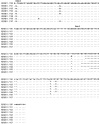PERB11 (MIC): a polymorphic MHC gene is expressed in skin and single nucleotide polymorphisms are associated with psoriasis
- PMID: 10691930
- PMCID: PMC1905592
- DOI: 10.1046/j.1365-2249.2000.01140.x
PERB11 (MIC): a polymorphic MHC gene is expressed in skin and single nucleotide polymorphisms are associated with psoriasis
Abstract
The susceptibility genes for psoriasis remain to be identified. At least one of these must be in the major histocompatibility complex (MHC) to explain associations with alleles at human leucocyte antigen (HLA)-A, -B, -C, -DR, -DQ and C4. In fact, most of these alleles are components of just two ancestral haplotypes (AHs) designated 13.1 and 57.1. Although relevant MHC gene(s) could be within a region of at least 4 Mb, most studies have favoured the area near HLA-B and -C. This region contains a large number of non-HLA genes, many of which are duplicated and polymorphic. Members of one such gene family, PERB11.1 and PERB11.2, are expressed in the skin and are encoded in the region between tumour necrosis factor and HLA-B. To investigate the relationship of PERB11.1 alleles to psoriasis, sequence based typing was performed on 97 patients classified according to age of onset and family history. The frequency of the PERB11.1*06 allele is 44% in type I psoriasis but only 7% in controls (Pc = 0.003 by Fisher's exact test, two-tailed). The major determinant of this association is a single nucleotide polymorphism (SNP) within intron 4. In normal and affected skin, expression of PERB11 is mainly in the basal layer of the epidermis including ducts and follicles. PERB11 is also present in the upper keratin layers but there is relative deficiency in the intermediate layers. These findings suggest a possible role for PERB11 and other MHC genes in the pathogenesis of psoriasis.
Figures



Similar articles
-
Duplication and polymorphism in the MHC: Alu generated diversity and polymorphism within the PERB11 gene family.Hereditas. 1997;127(1-2):37-46. doi: 10.1111/j.1601-5223.1997.00037.x. Hereditas. 1997. PMID: 9420468
-
A new polymorphic and multicopy MHC gene family related to nonmammalian class I.Immunogenetics. 1994;40(5):339-51. doi: 10.1007/BF01246675. Immunogenetics. 1994. PMID: 7927538
-
Allelic and interlocus comparison of the PERB11 multigene family in the MHC.Immunogenetics. 1997;45(3):209-16. doi: 10.1007/s002510050191. Immunogenetics. 1997. PMID: 8995188
-
Human Leukocyte Antigen-Class I Alleles and the Autoreactive T Cell Response in Psoriasis Pathogenesis.Front Immunol. 2018 Apr 30;9:954. doi: 10.3389/fimmu.2018.00954. eCollection 2018. Front Immunol. 2018. PMID: 29760713 Free PMC article. Review.
-
[Human histocompatibility HLA system. Considerations in the light of current concepts. VIII. Polymorphism of HLA-related MIC system].Przegl Lek. 2001;58(12):1076-8. Przegl Lek. 2001. PMID: 12041026 Review. Polish.
Cited by
-
[Psoriatic arthritis].Wien Med Wochenschr. 2006 Nov;156(21-22):587-95. doi: 10.1007/s10354-006-0276-7. Wien Med Wochenschr. 2006. PMID: 17160376 Review. German.
-
Heat treatment increases the incidence of alopecia areata in the C3H/HeJ mouse model.Cell Stress Chaperones. 2010 Nov;15(6):985-91. doi: 10.1007/s12192-010-0209-7. Epub 2010 Jun 27. Cell Stress Chaperones. 2010. PMID: 20582641 Free PMC article.
-
Leveraging NKG2D Ligands in Immuno-Oncology.Front Immunol. 2021 Jul 29;12:713158. doi: 10.3389/fimmu.2021.713158. eCollection 2021. Front Immunol. 2021. PMID: 34394116 Free PMC article. Review.
-
Genetic factors in psoriatic arthritis.Curr Rheumatol Rep. 2005 Aug;7(4):306-12. doi: 10.1007/s11926-005-0041-8. Curr Rheumatol Rep. 2005. PMID: 16045834 Review.
-
Major histocompatibility complex (MHC) associations with diseases in ethnic groups of the Arabian Peninsula.Immunogenetics. 2021 Apr;73(2):131-152. doi: 10.1007/s00251-021-01204-x. Epub 2021 Feb 2. Immunogenetics. 2021. PMID: 33528690 Free PMC article. Review.
References
-
- Tiilikainen A, Lassus A, Karvonen J, Vartiainen P, Julin M. Psoriasis and HLA-Cw6. Br J Dermatol. 1980;102:179–84. - PubMed
-
- Ikaheimo I, Silvenoinen-Kassinen S, Karvonen J, Tiilikainen A. Alanine at position 73 of HLA-C is associated with psoriasis vulgaris in Finland. Br J Dermatol. 1994;131:257–9. - PubMed
-
- Roitberg-Tambur A, Friedmann A, Tzfoni E, et al. Do specific pockets of HLA-C molecules predispose Jewish patients to psoriasis vulgaris? J Am Acad Dermatol. 1994;31:964–8. - PubMed
-
- Asahina A, Akazaki S, Nakagawa H, Kuwata S, Tokunaga K, Ishibashi Y, Juji T. Specific nucleotide sequence of HLA-C is strongly associated with psoriasis vulgaris. J Invest Dermatol. 1991;97:254–8. - PubMed
-
- Tsuji K, Inouye H, Nose Y, Sasazuki T, Ozawa A, Ohkido M. Further study on HLA-A, B, C, D, DR and haplotype antigen frequencies in psoriasis vulgaris. Acta Dermatovener. 1979;87:107–8. - PubMed
Publication types
MeSH terms
Substances
LinkOut - more resources
Full Text Sources
Medical
Molecular Biology Databases
Research Materials
Miscellaneous

